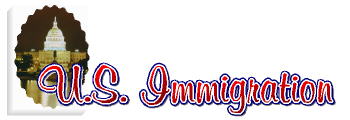 The information on this page is aimed primarily at those who have already married a U.S. citizen and wish now to reside in the United States with their spouse. If (like me) you have had to leave the US after your marriage you must remain outside the US until your application for immigration is approved. If however you married in the US and remained in the country the paperwork is much the same.
BUREAU
OF CITIZENSHIP & IMMIGRATION SERVICES (BCIS)
SUMMARY OF REQUIREMENTS For Residency
via Marriage you will need to obtain the following:
The BCIS requires original documents wherever possible. If you can't provide an original, and you are unable to obtain one, you must submit a notarised copy. You can obtain a kit for Residence via Marriage from the American Immigration Center which will give you all the forms and instructions you need in order to apply. The forms included in this kit are: Form
I-130 Petition for Alien Relative
The forms in this kit can also be downloaded from the BCIS website at the following link:
IMMIGRATION, THE BCIS, AND OTHER EVILS ... After my marriage to Greyhame on February 14, 1998, I had to return to Sydney Australia to finalise my financial affairs, sell what property I couldn't take with me, pack up and send what property I could take with me, quit my job and move to the United States. No small feat. I flew back to Sydney on February 20, 1998 and Grey submitted his Petition for Alien Relative on March 16, 1998. This is the application that the BCIS needs to appove. The rest of the paperwork is for consular approval in your own country. We thought it would take perhaps two months to be approved -- three if we were unlucky. We were unlucky. It took eight months. I'll tell you what happened, but first you need to know about ... THE PROCESS OF FILING AND APPROVAL Your U.S. citizen spouse has only two sets of paperwork to worry about. First is the Petition for Alien Relative, which he/she completes, signs, attaches the appropriate documents and photos to and sends to the BCIS together with the required lodgement fee (refer to the American Immigration Center for current fees.) The second is the Affidavit of Support, which is required to prove that your spouse is capable of supporting you (regardless of whether or not you work in the US) and that you won't apply for welfare or any kind of government support. They won't admit you if they think you're going to be a liability. Your spouse must send the completed Affidavit to you, if (like me) you are not in the United States at the time of lodgement. The Affidavit and its supporting documentation is to be included in your submission to your local U.S. Consulate. You, as the intending immigrant, have the heavier paperwork load. Your local U.S. Consulate should send you an information package upon request, and it should contain a checklist of items you must gather. In Australia the Consulate will not interview you until you have collected all the items on their list, and I assume the same procedure is followed by U.S. Consulates worldwide. The Consulate does not dictate policy, it merely follows the instructions of the BCIS, and they are not at liberty to bend the rules. Once you have everything necessary you must sign and date the checklist and send it back to the Consulate. Only the checklist is sent, not the other paperwork. That goes with you when you present yourself to be interviewed by a consular officer. Thepurpose of the checklist is to advise the Consulate that you have everything you need and are ready to be interviewed. They will not schedule an appointment for an interview until they receive that checklist. The documents you must gather are listed above. Police Certificate (which requires fingerprinting), Medical Exam, Birth Certificate etc. It takes longer to collect these items than you might think. Once you've got them all and have returned your checklist to the Consulate you may then have to wait until the BCIS in the United States has approved your spouse's Petition for Alien Relative. The Consulate requires the approved Petition before it will interview you. Once you are given an appointment (advised in writing) you will be provided with a list (yes, another one) which details the order in which all your paperwork must be sorted. The reason for this is to speed processing of the documents at your interview. If you don't sort everything according to the list before you go to the interview they will make you do it when you get there, so be prepared. When your application is approved at the interview and you have paid your fees you will be given an Immigrant Visa and Alien Registration. It's a separate official document, not merely a stamp in your Passport. All the other paperwork is attached to it and sealed in an envelope which must not be opened by you. It is to be handed to the Customs official at the port of entry into the United States. So, for instance, if you fly into the USA via Los Angeles you must hand the unopened envelope to the BCIS officer at the appropriate window. (When I came through LAX on October 24, 1998 it was window #18, which was a delight as there was no one else in the queue!) Now, before we turn the page I wish to clarify the following point of U.S. immigration law. If I had been able to remain in the United States after marrying Grey, I could have submitted all the necessary paperwork, applied for a change of visa status, and remained legally in the country. HOWEVER! Because I left the country I was not permitted to re-enter the USA until the immigrant visa had been approved. Not even temporarily to visit my husband! If I had tried to go back, and if they had discovered that I had an immigrant visa application pending approval, I would have been unceremoniously deported and the entire application process may have been fatally delayed. What, you might
ask, is the difference? Whether or not I'm in the USA when I apply for
residency, I'm still the same person, applying for the same thing! My husband
asked that question of the office of his local congressman, and they couldn't
answer it either.
Site Map | Immigration Directory | Our Story | Guest Book | Home
|

